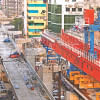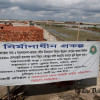Dhaka sees changing skyline indicative of growing economic strength

Although infrastructural development in Bangladesh has been mostly Dhaka-centric, the capital city's ever-changing skyline is a testament to the country's economic growth, according to experts.
High-rise buildings improve the efficiency of land use by providing more residential or commercial space per square metre, making them more suitable for densely populated areas.
As such, a number of skyscrapers have popped up in Dhaka, indicating a thriving business environment and rising investment in the capital city.
Although there is no universally accepted definition of a skyscraper, they are generally defined as being at least 100 metres, or 330 feet, in height.
A 100-metre building can have as many as 50 storeys depending on its structure, but a residential tower of that height is usually about 30 storeys tall.
And at present, there are around 20 commercial skyscrapers in Dhaka that fit the description.
For example, the City Centre Dhaka in Motijheel comprises 37 floors, the Pinnacle in Tejgaon has 40 floors and Hilton Dhaka in Gulshan features 34 floors.
Before 2012, the tallest building in the capital was the 31-storey head office of Bangladesh Bank.
"The construction of high-rises began just one-and-a-half decades ago, but it is common now," said Shahriar Kamal, group managing director of Concord Group of Companies.
This is because the efficiency of local civil engineering and construction companies improved over the years, making the construction of 30-storyed buildings normal for them.
In the past, businesses would hire foreign firms to construct their corporate offices, but this trend has changed over time as local companies have achieved international standard capacity and efficiency.
"Now, we only hire foreign consultants for the construction design of high-rise buildings," Kamal said, adding that even this will stop after the learning process is complete.
He also said more skyscrapers are being constructed in Dhaka thanks to the availability of customers, with there being about two dozen projects for 30-storey buildings so far.
Besides, skyscrapers reflect the country's economic capacity, Kamal added.
Kamal said he appreciates the Bangladesh National Building Code-2020 as it ensures compliance with international quality and safety standards in construction, which is encouraging for high-rise buildings.
Mahfuja Aktar, town planner (planning and implementation) of Rajdhani Unnayan Kartripakkha (Rajuk), said they approved the building code with permission from the Civil Aviation Authority.
According to her, there is no height cap for buildings in Dhaka's Purbachal. However, the skyline limit is up to 500 feet for different zones of the capital city.
Also, factors such as soil quality need to be considered when approving high-rise projects, she added.
Mehedi Ahmed Ansary, a professor of civil engineering at Bangladesh University of Engineering and Technology, said there is no doubt about the local companies' ability to construct high-rise buildings.
Besides, locally available construction materials like rod and cement have reached international standards. So, the construction quality is very good, he added.
Ansary informed that while there is no written guideline on building height, Rajuk and the Civil Aviation Authority are the main regulatory bodies in this regard.
He opined that the increasing number of skyscrapers are a reflection of the country's economic resilience even in face of ongoing economic vulnerability stemming from global crises.
However, the building safety expert said Dhaka cannot support more high-rise buildings as the city lacks adequate space and connectivity.
So, developers should focus on some of satellite cities in order to reduce population density, he added.
The 40-storey Pinnacle, a commercial property being built by Shanta Holdings Ltd on 45 kathas of land, is set to be the country's tallest building.
Shehab Ahmed, senior general manager of Shanta Holdings, said the building could have been 45-storeys tall for being 500 feet in height.
"But we kept the ceiling height at 11.5 feet to ensure superior aesthetics, quality internal functionality, and world-class heating, ventilation and air conditioning solutions," he added.
Currently, the City Centre Dhaka, a commercial structure, is the country's tallest building while the under-construction Hilton Dhaka, a Hilton brand hotel, is the second tallest.


 For all latest news, follow The Daily Star's Google News channel.
For all latest news, follow The Daily Star's Google News channel. 








Comments